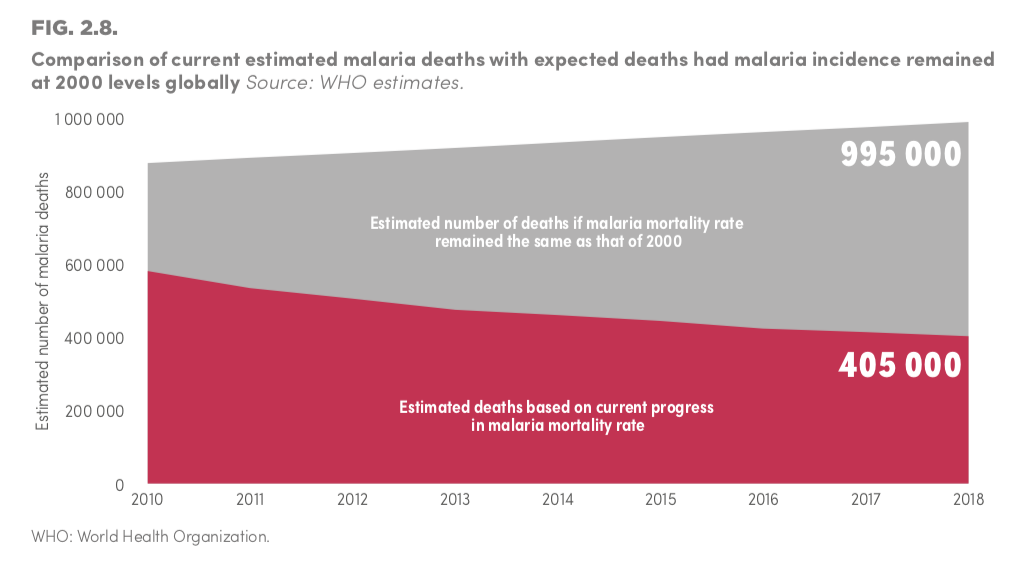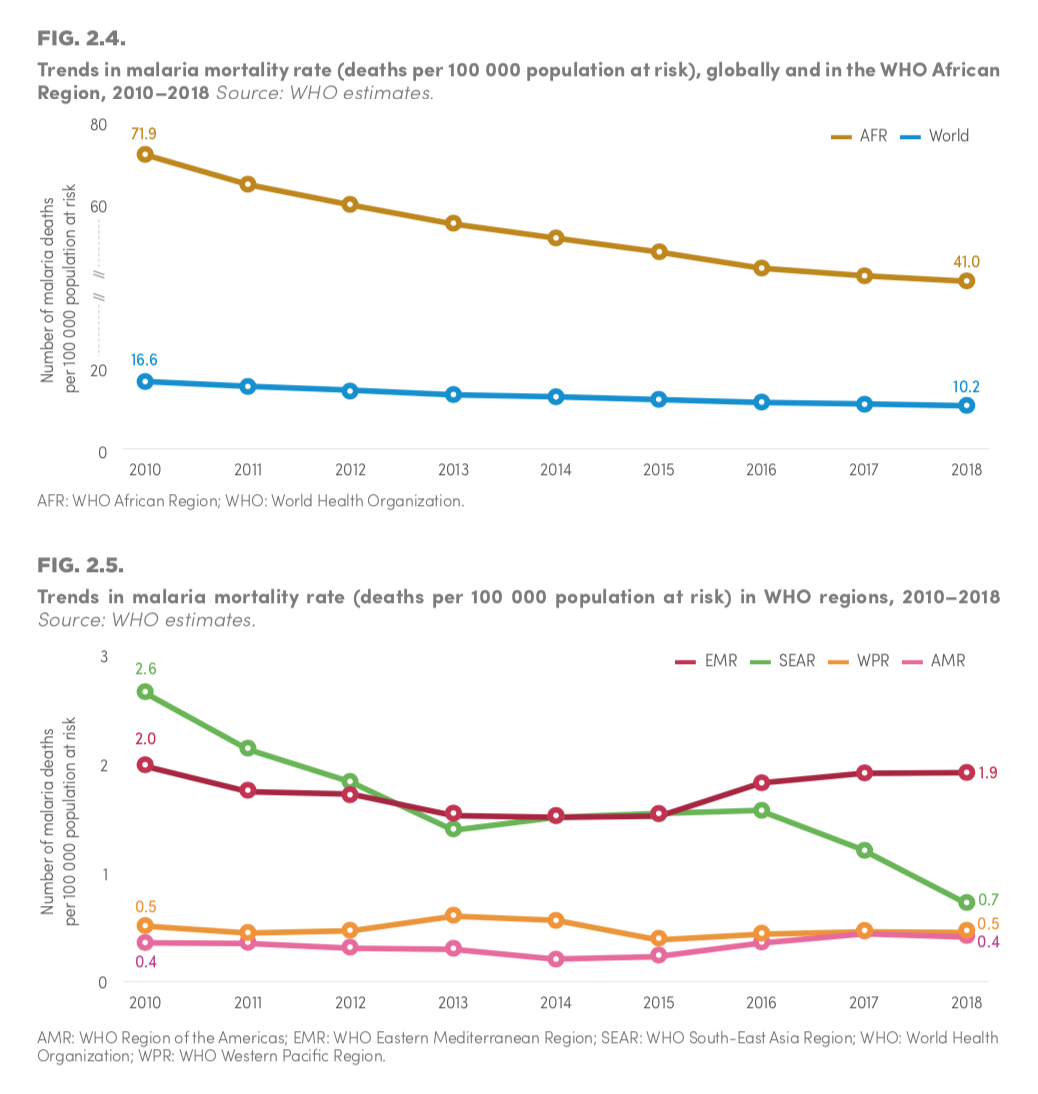Today, the World Health Organization (WHO) released its 2019 World Malaria Report, an annual report that provides a comprehensive update on global and regional malaria data and trends. The report tracks investments in malaria programs and research as well as progress across all intervention areas: prevention, diagnosis, treatment and surveillance. We’ve taken a look at the report, and here’s what you need to know.

Global progress in malaria control and elimination efforts continues– with malaria cases and deaths at historically low levels- but progress is fragile, cannot be taken for granted, and needs to accelerate.
- While in most parts of the world, a child who gets malaria today has a better chance of survival than at any other point history, global progress in reducing the rate of new infections has slowed. In 2018, there were an estimated 228 million cases compared to 231 million in 2017. The global incidence rate of malaria (number of cases per 1000 population) fell from 71 in 2010 to 57 in 2014 and remained at similar levels through 2018.
- Every year, global investments and action against malaria are making a huge difference—without these, malaria deaths and cases would be significantly higher. Global efforts have saved more than 7 million lives since 2000 with estimates showing that in 2018, global efforts saved almost 600,000 lives per year and prevented almost 100 million malaria cases per year compared to 2000.
- We’re off track on our 2030 goals. The WHO Global Technical Strategy calls for reductions in case incidence and death rates of at least 40% by 2020, compared to a 2015 baseline. In view of recent trends, these two targets will likely be missed.
- More countries than ever are within reach of elimination. In 2018, two countries were awarded the official WHO certification of malaria elimination: Paraguay and Uzbekistan. Two more countries – Algeria and Argentina – were certified malaria-free in 2019. In 2018, 49 malaria-endemic countries reported less than 10 000 cases of the disease, up from 40 countries in 2010. Twenty-seven countries had less than 100 cases – a strong indicator that elimination is within reach – up from 17 countries in 2010.

Malaria increasingly is a disease of poverty and inequity, with the most vulnerable– specifically pregnant women and children under five- at greatest risk of dying from a mosquito bite.
- Children under the age of 5 accounted for two thirds (67%) of global malaria deaths in 2018.
- Malaria continues to strike hardest against pregnant women and children in Africa. In 2018, an estimated 11 million pregnant women living in 38 countries with moderate-to-high transmission in sub-Saharan Africa were infected with malaria (29% of all pregnancies).
- An estimated 872,000 children in 38 African countries were born with a low birth weight due to malaria in pregnancy. Low birth weight complicating malaria in pregnancy puts a child at a greater risk of infant mortality and cognitive impairment.
- There has been increased coverage of interventions to protect pregnant women and children in Africa but it’s not sufficient. An estimated 61% of pregnant women in the region slept under an Insecticide Treated Net, up from 26% in 2010. The percentage of eligible women receiving the 3 recommended or more doses of Intermittent Preventive Treatment in Pregnancy (IPTp) increased from 22% to 31% in just one year, but still is far from universal coverage.
The WHO strategy for reducing malaria cases and deaths by 90% by 2030 is underfunded.
- In 2018 there was a US$2 billion gap in funding to reach all those at risk with life-saving malaria interventions.
- To achieve the 2030 targets for malaria, we must accelerate the rate of progress by increasing funding to US$5 billion per year. The new sources of funding must come from a mix of malaria-affected country financing, innovative financing solutions and ensuring donor commitments are met or increased.
- From 2010 to 2018, an estimated US$9.4 billion in funding was directed to the 11 highest burden countries, of which 82% came from international sources.
- The United States continued to be the largest international source of malaria funding. Strong, robust U.S. leadership and funding for programs like the President’s Malaria Initiative and the Global Fund to Fight AIDS, Tuberculosis and Malaria has been a huge driver of progress thus far. We need continued and stepped up leadership in order to achieve our elimination targets and overall goal of eradication.
So, what now? What is needed to help Step Up The Fight against malaria?
- New and improved malaria-fighting tools and strategies will be critical to accelerate the pace of progress. There are several biological challenges including Pfhrp2/3 gene deletions, drug resistance and insecticide resistance, which threaten progress against malaria. We need to ensure that new and improved innovations can be strategically deployed and scaled up to reach the people who need them as well as encourage continued research and development and innovation as to stay ahead of the evolving parasite. Learn more about how innovation and tools are leaving an impact in the Americas: https://nothingbutnets.exposure.co/malaria-in-the-americas
- Stepped-up financing is essential. Current resources are not sufficient to reach our targets and goals. New sources of funding must come from a mix of malaria-affected country financing, innovative financing solutions and ensuring donor commitments are met or increased. Continued and stepped up U.S. leadership and funding is absolutely critical. Learn how the Global Fund financing impacts malaria elimination: https://nothingbutnets.exposure.co/the-global-fund-malaria
- Ultimately, universal health coverage is key to success. All people at risk of malaria – particularly pregnant women and children – must have access to the primary health care services they need to prevent, diagnose and treat this deadly disease. Learn how Universal Health Coverage and malaria are interconnected here: https://nothingbutnets.exposure.co/sdg
What can I do?
- Join champions from across the U.S. at the United Nations Foundation’s Nothing But Nets’ 2020 Leadership Summit March 8-10, 2020 to advocate to your Members of Congress around the need for stepped up leadership in the fight against malaria: https://nothingbutnets.net/forms/2020summit
- Donate to Nothing But Nets End of Year Fundraising Campaign, to protect children at risk of malaria in Niger. Together, we can protect 100,000 children from malaria by December 31st! https://act.nothingbutnets.net/onlineactions/G4sXwjZS7UeQslJrRmLfYg2
- Learn more:
Our Statement:
